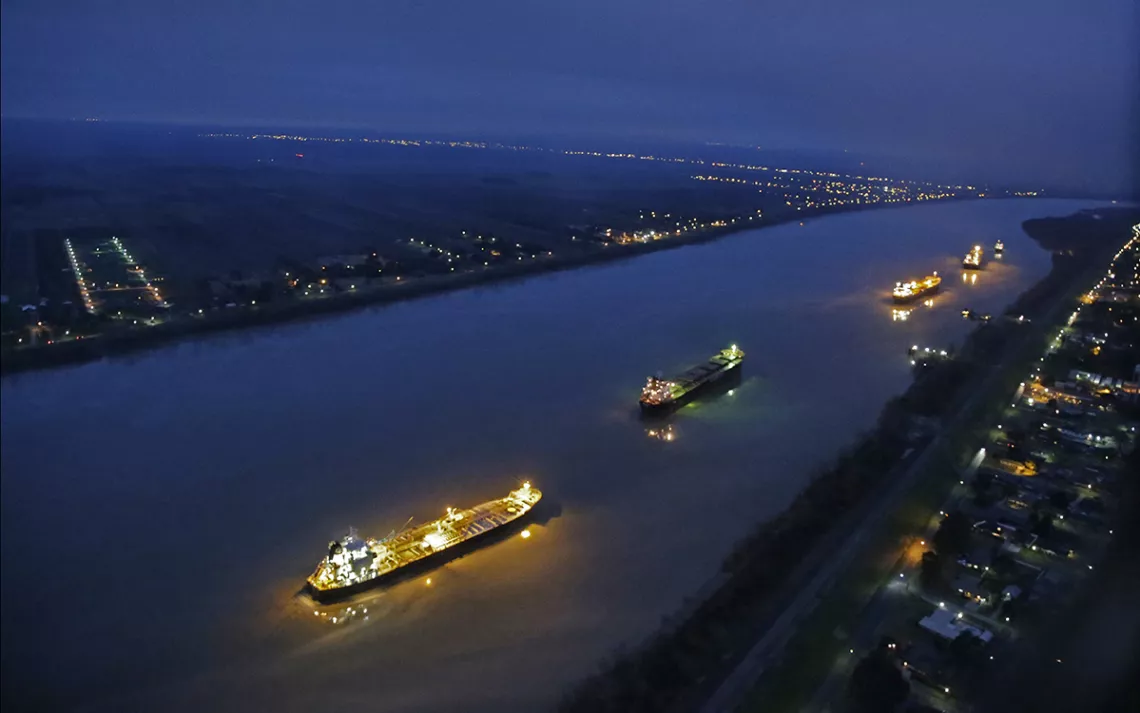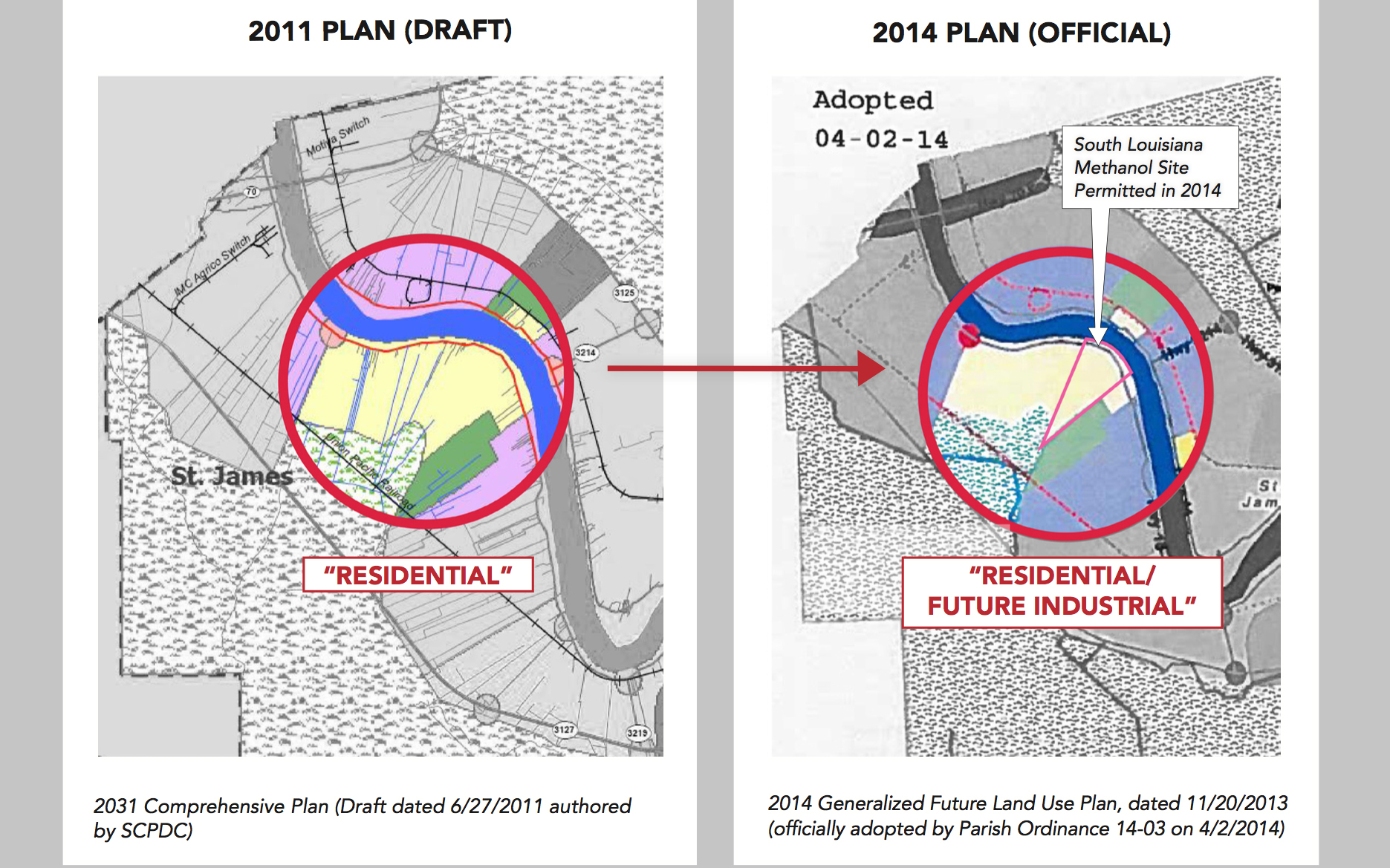The Revolution in St. James
A community in Louisiana refuses to be zoned out of existence

The Mississippi River between New Orleans and Vacherie, LA, due to a barge leaking oil in St. James Parish | Feb. 23, 2014 | Photo by AP Photo / Gerald Herbert
Sharon Lavigne’s home is on the levee in the 5th district, near a river road that winds along the Mississippi and serves as a primary thoroughfare through the parish. Chemical plants dot both sides of the river, enjoying easy transit and close proximity to the Gulf of Mexico.
For decades, most residents of the 4th and 5th districts of St. James parish grudgingly coexisted with these plants. They believed in their promises of jobs and economic growth, and assumed some pollution was a necessary risk. As oil and gas drilling began to boom in the United States, pipelines began networking their way across the region, connecting oil and gas to the plants, where they could be converted into valuable components for plastics manufacturing. Today, the parish is home to trillions of dollars in petrochemical infrastructure.
Industry takes over
And even more is on the way. There are more than half a dozen chemical plants planned for construction in St. James parish, about 50 miles upriver from New Orleans in south Louisiana. Eight currently operate in the 5th district alone. Companies from around the world hope to utilize already established petrochemical infrastructure and numerous pipelines, with generous tax breaks from the state providing extra incentive.
All the construction, and extant industry, is in St. James’s majority African American 4th and 5th districts. As the chemical industry has expanded, schools, businesses, and even a post office have closed. “We lost everything,” said Myrtle Felton, who has lived in the 4th district all her life. “You can’t buy a pair of shoes in this district. There’s one restaurant, and it’s only open during the day.”
St. James wasn’t always like this. Older residents remember a tightly knit, largely agricultural community, where people lived off the land, swamps, and the river.
“Before industry took over, we had clean air and productive land,” Lavigne said. “My grandfather caught fish and shrimp in the Mississippi River. We had fig and pecan trees that kept us well fed and gave us something to sell. It was peaceful and quiet. Now the land and everything that grows on it is poison. Now, our houses are flooding when there’s heavy rain.”
“This was a nice place to live," Felton said. “It was safe. Your parents would let you walk to the store and play outside. Now there’s a lot of noise and a lot of pollution. You can’t keep your house clean. I’m lucky I can’t smell it because my sinuses stay backed up.”
A place called "Freetown"
St. James’s 250 square miles encompasses both the east and west banks of the Mississippi River, and for centuries people have farmed that fertile land. White settlers built plantations and brought thousands of enslaved African Americans to the area. After the Civil War, slaves established their own farms and communities with names like Welcome, Freetown, and Convent. Some people fighting to stop development in St. James can trace their roots to these towns’ founders.
The chemical industry first came calling in the late 1960s. One of the first facilities was Dupont, in neighboring St. John the Baptist parish. Most residents initially saw the plants as an opportunity for higher wages and steadier employment. “Looking back on it, it’s hard to say when things started changing,” Felton said. “At first, we thought things were getting better. My husband worked at a plant. Even when I heard they were building Nucor less than a mile from my house, I said, ‘It won’t be that bad.’ Then, people started getting sick.”
In the 1980s, the 85-mile stretch between Baton Rouge and New Orleans acquired the nickname “Cancer Alley,” based on the deeply feared negative health impacts associated with the densest concentration of the petrochemical industry in the United States. For decades, companies have denied that their pollution has harmed area residents, but recent research, including a 2014 EPA study that found a census tract near the Denka Dupont plant in neighboring St. John the Baptist parish to have the highest risk of liver and lung cancers in the country, clearly demonstrates the potential risk of being close to industry. “People here either leave or they get sick and die,” Lavigne said.
In 2014, parish officials decided to change the 4th and 5th district’s zoning code in a new land-use plan, renaming residential areas in certain parts of the districts “residential/future industrial.” Within a year, several plants were approved in the newly zoned areas, including Taiwanese-owned Formosa, a 13-plant complex slated for construction less than a mile from the 5th District Elementary School.
“My home is in the northern part of the 5th district, and they didn’t even tell me that they rezoned it for industrial use,” Lavigne said. “Nobody asked us. They told us Formosa was coming to the 5th district and that it was a done deal.”

St. James Parish was rezoned from residential to residential/industrial. | Image courtesy of the Louisiana Bucket Brigade
A "stagnant population"
St. James’s land-use attorney described the zoning changes as the result of a “stagnant population” in the 4th and 5th districts, something urban planner Justin Kray questions after writing a report on the parish’s land-use plan called A Plan Without People: Why the St. James Parish 2014 Land Use Plan Must Be Changed. “It’s true that the population hasn’t grown as much as other areas of the parish,” Kray said, “But it’s kind of a chicken-or-egg scenario. Are they actively divesting in community services and destroying property values by making it untenable to live there? Or are services disappearing because people are leaving this part of the parish?”
About a year after St. James parish changed its land-use plan, the Department of Energy began allowing exports of gas. This change, coupled with newly arriving crude traveling via the Dakota Access Pipeline from Canada, meant a potential explosion in St. James’s production capabilities. Residents in the 4th and 5th districts saw the list of chemical companies planned near their neighborhoods and decided they had had enough. It was time to organize.
“They already aren’t monitoring the facilities we have,” Lavigne said. “What will happen to us if there is even more pollution? Some of these companies, like Formosa, have a terrible track record. I know that democracy hasn’t fully come to this parish.”
Zoned out of existence
When St. James parish officials decided to create a new land-use plan in 2014, few residents took notice. There were two public meetings over the course of two weeks, which 18 people attended, and the plan was subsequently adopted. Shortly after, the parish’s land-use committee granted permits to more than half a dozen companies, including Formosa, Ergon, Syngas, South Louisiana Methanol, Wanhua, YCI, and Linde. It didn’t take long for people in the 4th and 5th districts to realize the zoning code no longer recognized their schools, churches, and other public institutions, and that the government considered their neighborhoods part of an industrial expansion project.
“My great-great-great-grandmother came out from slavery, and in 1874 she purchased 34 acres of land that is still in our family today,” said 4th district resident Barbara Washington. “I can’t just sit down and let industry come in and do this to us. It just can’t happen. So I’m fighting.”
St. James vs. the chemical plant
Washington’s home sits near two currently operating facilities—Occidental and Mosaic—as well as the proposed construction site for Wanhua, a Chinese-owned company that submitted plans for a $1 billion plastic manufacturing facility to parish officials in early 2019. Advocacy groups including the Louisiana Bucket Brigade and the Tulane Environmental Law Clinic began studying Wanhua’s permit application after residents like Washington voiced concern about the cumulative environmental impact of plants in the area. It led them to the parish’s land-use plan.
“We found that the 2014 land-use plan removed protections for people in the 4th and 5th districts,” said Justin Kray, an urban planner who worked with the Bucket Brigade to analyze the plan. “Several schools and churches in these majority African American districts were not included. If they had been, it would have created an opportunity for public input on the location of several major facilities including Wanhua and Formosa.”
Kray, along with Anne Rolfes, executive director of the Louisiana Bucket Brigade, began investigating how the land-use plan was created. Numerous public records requests led to a dead end.
But two parish leaders who shepherded the plan, Blaise Gravois and Timmy Roussell, were indicted for corruption in 2016, on charges of misusing parish funds for their own benefit. They remain in office. "In St. James parish, you have lots of money floating around from private industry, and parish officials who have already been indicted for malfeasance," Rolfes said. "The land-use plan was a prime opportunity for corruption."
A surprise twist
Based on the Bucket Brigade’s research into the land-use plan, and the plant’s projected harmful emissions, the Tulane Environmental Law Clinic appealed Wanhua’s land-use permit in May 2019, meaning that the St. James parish council would also have to approve the permit. Before the appeal hearing, parish officials got a letter from the Port of South Louisiana. Wanhua had applied to receive foreign trade zone status. If it was approved, it would be exempt from federal tariffs as well as local sales and inventory taxes. Suddenly, parish officials did not know if they would receive any revenue from the project.
Also thrown into question was Wanhua’s status as a Chinese company. It was technically government-owned, and that meant that it was potentially not subject to environmental regulation as a result of state immunity, which prevents nations from suing other nations in their own courts. Wanhua promised that they planned to follow the law and pay sales tax, but parish officials balked and returned the permit to the planning commission for further review.
“If local residents hadn’t appealed this permit, the parish never would have had an opportunity to further review Wanhua after they learned about the foreign trade zone,” Rolfes said. “Without resistance from the local community, there wouldn’t have been time for those economic realities to take root.”
Before the planning commission could make a new decision on Wanhua’s land-use permit, the company pulled it from consideration at the beginning of September. They cited rising construction costs as their reason, though they did not disclose how or why construction costs associated with the project had increased, or if recently imposed tariffs had impacted their decision to withdraw the permit application.
“We know in the past they’ve said the tariffs will impact whether or not they come here. But they also say they still plan to come to St. James or somewhere in Louisiana, so that can’t be the only reason they withdrew the permit,” Rolfes said. “Vehement local opposition definitely played a role in the decision.”
“They want us to stop fighting this"
With this recent victory against Wanhua comes the knowledge that stopping new industry is possible. Residents have already turned their attention to another petrochemical complex making its way through the permitting process: Formosa. The state of Louisiana is currently reviewing the company’s air permit application, which received thousands of public comments in opposition.
“The parish government had a big party celebrating Formosa and all the billions they were going to get,” Lavigne said. “They want us to stop fighting this. They approved it. We are going to keep fighting and keep appealing, because they aren’t treating us like people.”
In addition to fighting Formosa, residents are pushing for a new land-use plan, and further review of permits approved using the flawed maps and zoning. “These permits were issued under a secretive land-use plan that targets the black community,” Kray said. “We believe they should be revoked and that the origin of these zoning changes needs to be further investigated. There are trillions of dollars going into these petrochemical projects. It’s a prime opportunity for corruption, and we have to make sure the government is held accountable.”
 The Magazine of The Sierra Club
The Magazine of The Sierra Club



